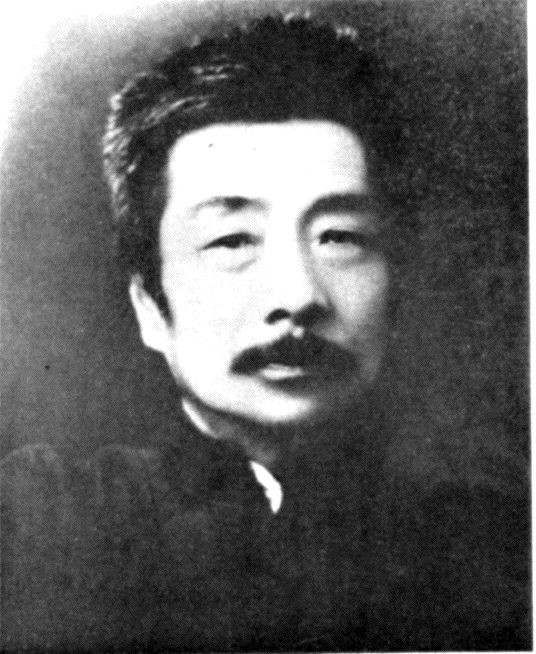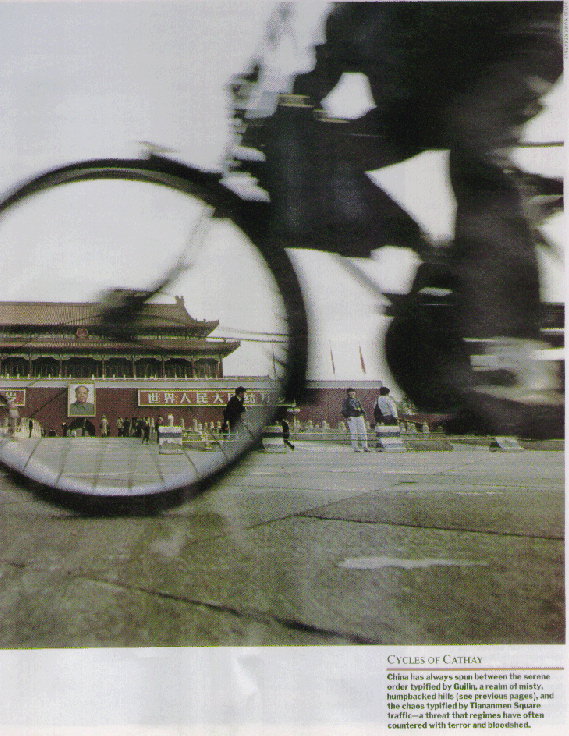Abstract

Lu Xun (1881-1936)
The May Fourth
Movement occurred roughly from 1917 until 1921. The name of the movement
was from the demonstrations which occurred on May 4th, 1919 in Tiananmen
Square. Students from the University of Beijing were angry about the exclusion
of Chinese interests during the Paris Peace Conference after the end of
World War I. It was a nationalist movement that was marked by its desire
to modernize the nation, through art, literature, philosophy, and most
importantly in world history, politics. After years of domination by the
West and Japan, young intellectuals in China began the New Cultural Movement
to revive the nation.
Historical
Background
On May 4th, 1919, around 3,000 students from the University of Beijing
(Peking) went to Tiananmen Square to protest the further interference of
foreign imperialist powers in the affairs of the Chinese government. The
Chinese had joined World War I on the side of the Allies in hopes of regaining
their provinces lost over the years to imperialist Western powers, yet
the interests of the Chinese were completely ignored at the Paris Peace
Conference at the end of the war. One area in question, the province of
Shandong, had been under German control for some time. The Chinese believed
they would be able to regain it after being on the Allies side; however,
it was given to the Japanese instead. Also during this time Japan had issued
the Twenty-One
Demands to China, which was a humiliating experience for the once powerful
nation. This caused a strong anti-Japanese movement in China, which eventually
turned into an anti-imperialist movement.
The demonstrations were a culmination of the frustrations of the young
Chinese who were becoming strong nationalists. The protests were fought
by the Chinese warlord government and 32 protestors were arrested. From
June 2-4, 1919, there were mass arrests of 1,150 students in Beijing. the
movement spread to other schools in cities like Shanghai, and the student
cause was supported by workers' and merchants' protests. The movement was
too strong, however, and the arrested were released, and by June 28th the
government refused to sign the Versailles Treaty. The entire period from
1917 until the early 1920s is generally referred to as the May Fourth Movement,
and it symbolized more than the student protest. It marked a cultural change
in China. Besides the student protests there were workers' and merchants'
protests, an intellectual movement, and a boycott of Japan. Politically,
the nationalist movement evolved further into a Marxist shift in
ideology among some Chinese. Also, language and art were greatly affected
by the changing cultural mood. China was searching for a political as well
as cultural balance, and the intellectuals of the day were trying to find
the answer.
Research
Report
A
main figure of the changing times was Chen Duxiu (Ch'en Tu-hsiu,1879-1942).
Chen was the dean of the University of Beijing at the time of the movement,
and was also a staunch Marxist. He was not always that way, however; he
originally was in favor of science and democracy in China, but eventually
decided that Marxism would be the fastest way to bring China back as a
strong and modern nation. He became so involved in his Marxist beliefs
that when the Chinese Communist Party (CCP) was founded in July of 1921,
he was nominated and elected as its first Secretary General. His hopes
for modern China put the traditional Confucian ideas to the wayside and
on the defensive. In 1915 Chen founded the literary journal New Youth,
a
catalyst of the movement, as a forum for these new ideas that were coming
out of the university faculty and students.

The New Youth was more than just another literary journal, it was
a core element of the new movement among the educated in China. It called
for the revitalization of Chinese society, which had been under Western
and Japanese domination for many years. Its authors denounced the old ways
of Confucianism and tradition, instead calling for China to follow new
Western ideas and update itself to reemerge as a strong nation which could
hold its own with the rest of the world. Writers such as Lu Xun (Chou Shu-jen,
1881-1936), China's most acclaimed 20th century author, got their first
opportunities to be published by New Youth. The journal called for the
use of the vernacular in everyday writing rather than the traditional Chinese
writing that most people could not read. No one person championed this
cause more than American educated Hu Shih (1891-1962). Hu was an editor
at the Chinese Students' Monthly, and was a former student of John Dewey.
Through his and others' efforts, by 1920 elementary school were beginning
to use the vernacular in teaching, and by the end of the decade it was
in everyday use just as Hu Shih had hoped for. New Youth, its ideals,
and its contributors brought about an intellectual change among all Chinese
people, not just the students it had been originally aimed at. Its articles
helped in bringing about the May 4th protests, and also helped trigger
the new way of thinking in China which came to be known as the May Fourth
Movement.
Art, Literature, and Politics
Literature
and philosophy was greatly affected by the change in thought. Philosophically,
May 4th Movement thinking was greatly influenced by 17th and 18th century
French liberalism. This occured because prior to and during World War I
there was a work study program of sorts between the Chinese and the French.
Young Chinese men would go to France to work, freeing Frenchmen to fight,
and while there working the Chinese could study. Returning to China, students
brought back with them the ideas of democracy, socialism, anarchism, and
Marxism, among others. In literature, there was a great movement to use
the forum of journals to introduce new authors and new ideas to the forefront
of Chinese writing. No one exemplified this movement better than Lu Xun.
He was educated in Japan, and hoped upon his return to China to help find
a way through writing to make is native land modern and strong once again.
His most famous work, Diary of a Madman, was first published in
New
Youth in 1918. It made the claim that the past was evil, with the Chinese
feeding on each other, but now there was a new generation that could be
saved from this self-destruction. Lu Xun founded different literary societies,
including the Thread-of-Talk Society and the Leaugue of Leftist Writers.
Also, there were many translations made of Western works to classical Chinese
during this time, although it had actually been happening since the late
Qing. Authors such as Lin Shu (Lin Ch'in-nan, 1852-1924) translated the
works of Dickens, among others. Experimental forms of writing were also
coming into being, with romanticism becoming more popular in writings after
the removal of Confucian constraints in modern China. Communist and anarchist
writings were more prevalent than before as well during the movement. For
example, Ba Jin (b. 1905) was an anarchist author of the Turbulent Stream
trilogy, which was written from 1931 through 1940.
Art in China was affected in some ways by the new movement, but not to
the extent in which literature was. A few artists did make some changes
to the way they painted. There was a synthesizing of Chinese traditions
with western art of the day which created a new style in the country. Different
schools were opened in Shanghai and Canton which taught younger artists
about this combination, and brought about a modern style to Chinese art.
The Shanghai Art School was opened in 1920 by Liu Haisu (b. 1895). He introduced
the nude model to Chinese art, as well as an introductory class on Western
music. Also, in Canton, Xu Beihong (1895-1953), an artist who had lived
in Paris until 1927, brought with him the French Bohemianism of the times.
His art reflected this influence, but he returned to more modern Chinese
styles later in his career.
Politically, Marxist thought, which had been around prior to the movement,
began to gain momentum. After the 1917 revolution occurred in Russia and
Marxism was adopted as state rule, some Chinese began to see it as a viable
way for their own government to regain its strength. Communist groups began
to appear among universtiy students and spread to groups outside of the
college campuses. For example, a young Mao Tse-tung, at the time an assistant
librarian at Beijing University, organized the communist group New People's
Study Society in 1918. After the fall of the Qing in 1912 and the failure
of republicanism under Yuan Shikai's regime, Chinese nationalist revolutionaries
were searching for a new path to follow it either in Sun Yat-sen's democratic
vision or in Communism, which prevailed after World War II. Marxism had
the image of being modern and advanced. People such as Chen Duxiu and Li
Dazhao (Li Ta-chao,1888-1927), a fellow faculty member at Beijing University,
were ardent Marxist revolutionaries who hoped for a communist government
not unlike the one in Russia to save China from imperialism and warlords.
Li, Chen, and others founded the Chinese Communist Party in July of 1921,
with the aid of Gregori Voitinsky of Russia and the Comintern (Communist
International). With this new foundation, communist movement members hoped
that with the United Front cooperation with the Guomindang (KMT), China
would be strong once again.
Historical
Significance
The founding of the CCP in 1921 marked
the beginning of another era in China, which led to the Communist takeover
in 1949. The May Fourth Movement marked the end of old China and ushered
in the era of what we now know modern China to be. Politically, the movement
brought together the Chinese under a wave of nationalism which had been
missing since the end of the Sino-Japanese War. It revived a culture by
making it new again. Chinese intellectuals rejected tradition and adopted
Western ideas, synthesizing them into their own. It may have never gotten
off of the ground if it had not been for the revolutionary thinkers of
the May Fourth Movement. From the minds of people such as Chen Duxiu, Lu
Xun, Hu Shih, and Li Dazhao came a new nationalistic society, where China
finally could fight back against the dominating power of the West and Japan.
For better or for worse, the idealism of the educated Chinese in the early
1900's brought on a new era in Chinese history. Old China became new, without
emperors or warlords, but with pens and pencils, great minds and revolutionary
thought.
References
Chen, Joseph.
The
May Fourth Movement in Shanghai. Leiden, Netherlands: E.J.Brill, 1971.
Chow, Tse-tsung.
The
May Fourth Movement. Cambridge, Massachusetts: Harvard University Press,
1960.
Lin, Yu-sheng.
The
Crisis of Chinese Conciousness. Madison: The University of Wisconsin
Press, 1979.
Schwartz, Benjamin.
The
Chinese Enlightenment. Berkeley: University of California Press, 1986.
Reflections
on the May Fourth Movement: A Symposium. ed. Benjamin Schwartz. Cambridge:
Harvard University
Press, 1972.
Web Resources
www.china2thou.com/9812p7.htm
-Overview of the Movement by Wang Xiaoqui, history professor at Beijing
University
www.columbia.edu/cu/cear/issues/fall99/text-only/wang.htm
-Intellectual aspect of movement in relation to the PRC
and the1989 Tiananmen Square protests
library.thinkquest.org/26469/history/1928.html
-Brief section on the Movement and its relation to 1920's and 1930's history
in China
www.chinese-art.com/volume1issue5/special.htm
-Description of art evolving during the New Cultural Movement
www.watson.org/rivendell/historyeastintll.html
-Comparison/contrast between student protests of 1919 and 1989

